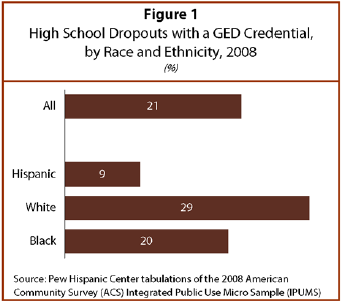
Further education and training is one of the paths to upward mobility for the nation’s 41 million high school dropouts. Dropouts with GEDs are much more likely to pursue postsecondary education and training than dropouts lacking a GED or other alternative credential. Among young dropouts without an alternative credential, only about 1-in-10 pursues any further education. If the dropout has a GED, about 4-in-10 get additional education (National Center for Education Statistics, 1998). And dropouts with GEDs are the only ones who are considered for admission to degree-granting colleges and universities, including community colleges. A GED is also required to obtain the federal Pell grant.
Newly available Census Bureau data reveal that Hispanic high school dropouts are the least likely of the major racial/ethnic groups to have a GED (Figure 1).1 In 2008, fewer than 1-in-10 Hispanic dropouts had a GED. Twice as many black dropouts have a GED (20%) and more than three times as many white dropouts had a GED (29%). Thus, the major racial/ethnic group having the lowest high school graduation rate from the public schools is also the population least likely to have the “second chance” credential providing opportunities for additional education.
Part of the reason that the educational prospects of Hispanic high school dropouts are dimmer than others’ prospects is the large immigrant presence among Hispanic adults. The new data suggest that it takes time for newly arrived immigrants to learn about educational opportunities, including attaining GEDs. The longer Hispanic foreign-born dropouts have been in the United States, the more likely they are to have a GED. Yet, among native-born Hispanic high school dropouts, only 21% have a GED.
The GED, or General Educational Development Tests, is the nation’s largest dropout recovery or second chance program. Administered by the American Council on Education (ACE), the GED has standardized tests in five areas. ACE sets the minimum passing standards. States award the GED credential to test takers in their states. Some states set passing standards above the minimum, and there may be additional tests to pass (such as civics), depending on the jurisdiction. Local school districts, community colleges, correctional facilities and the military are among the major providers of GED test preparation services for dropouts.
While obtaining the GED credential opens pathways for dropouts to pursue postsecondary education, it is not clear that the GED in and of itself benefits high school dropouts. The next section shows that on some outcomes, Hispanic dropouts with GEDs fare better than uncredentialed Hispanic dropouts. In the labor market, Hispanic dropouts with GEDs may even have more favorable outcomes than Hispanics who graduated from high school with a diploma, but generally Hispanics who end their education with a GED would have been better off staying in high school and graduating.




